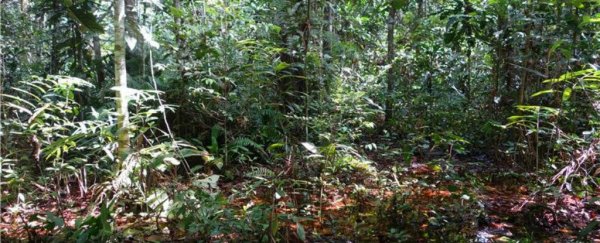A vast, peat-filled wetland has been discovered in the Congo Basin, spanning an area larger than England, and trapping an estimated 30.6 billion tonnes of carbon dioxide in its soil.
Thought to be the largest tropical peatland area on Earth, it contains three years' worth of global fossil fuel emissions, and scientists are now worried that development in the region could release the gas.
A joint UK and Congolese team has been exploring the area for several years now, and using a combination of fieldwork and satellite imagery, they've produced the first extensive map of the newly identified peatland.
They say that the fact that it's so rugged, swampy, and remote has kept it - and its massive carbon store - safe from developers until now, but that might not always be the case.
And if its water-logged soil begins to dry out due to land clearing and cultivation, that's when carbon dioxide will start leaking out into the atmosphere.
"It's very remote, but what we've seen in south-east Asia is that these once-remote areas have been dried out and converted to oil palm plantations and rice plantations and other forms of industrial agriculture, causing a huge release of carbon dioxide into the atmosphere," Simon Lewis from the University of Leeds in the UK told Reuters.
Also known as mires or bogs, peatlands only cover about 3 percent of the planet's total land surface, but they contain up to a third of all of the carbon locked in Earth's soils.
They're formed by an accumulation of partially decayed vegetation or organic matter in a wetland environment. Constant flooding prevents the soil from drying out, and also blocks oxygen flow from the atmosphere, which further slows the rate of decomposition.
As the American Geophysical Union explains, microbes living in water-logged soil are unable to produce an important enzyme called phenol oxidase, and this hinders their ability to break down plant material in an efficient manner - hence the slow rate of decomposition.
But if the soil starts to dry out, that enzyme becomes more active, and the microbes are no longer held in a perpetually near-starving state. This microbe revival sees them re-enter the carbon cycle, and the peatland will start releasing its carbon dioxide.
Lewis and his team estimate that carbon has been accumulating in the Congo Basin's peat for nearly 11,000 years, and we really can't afford to mess with that kind of stockpile.
"Peatlands are only a resource in the fight against climate change when left intact, and so maintaining large stores of carbon in undisturbed peatlands should be a priority," he said in a statement.
"If the Congo Basin peatland complex was to be destroyed, this would release billions of tonnes of carbon dioxide into our atmosphere."
The team caught a glimpse of the peatland in 2014, when they were exploring a large, densely forested depression in the Congo Basin called the Cuvette Centrale.
After two years of mapping and exploring, they can now confirm that the peatland covers some 145,500 square kilometres (56,177 square miles), and contains nearly 30 percent of the world's tropical peatland carbon.
The concern now is that, because the area has only just been mapped, there are currently no conservation plans in place to keep the developers at bay.
And even if there were, rising global temperatures and reduced rainfall could trigger the drying-out process on their own.
But despite the concerns that this vast, carbon-storing peatland raises, the fact that we're still discovering massive areas of the planet that we didn't even know existed has not been lost on the team.
"The sheer expanse of these peatlands makes central Africa home to the world's most extensive peatland complex," said one of the researchers, Greta Dargie from University College London.
"It is astonishing that in 2016 discoveries like this can still be made."
The study has been published in Nature.
